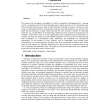Free Online Productivity Tools
i2Speak
i2Symbol
i2OCR
iTex2Img
iWeb2Print
iWeb2Shot
i2Type
iPdf2Split
iPdf2Merge
i2Bopomofo
i2Arabic
i2Style
i2Image
i2PDF
iLatex2Rtf
Sci2ools
113
Voted
PUC
2010
2010
What is happening now? Detection of activities of daily living from simple visual features
We propose and investigate a paradigm for activity recognition, distinguishing the ‘on-going activity’ recognition task (OGA) from that addressing ‘complete activities’ (CA). The former starts from a time interval and aims to discover which activities are going on inside it. The latter, in turn, focuses on terminated activities, and amounts to taking an external perspective on activities. We argue that this distinction is quite natural and that the OGA task has a number of interesting properties; e.g., the possibility of reconstructing complete activities in terms of on-going ones, the avoidance of the thorny issue of activity segmentation and a straightforward accommodation of complex activities, etc. Moreover, some plausible properties of the OGA task are discussed and then investigated in a classification study, addressing: the dependence of classification performance on the duration of time windows and its relationship with actional types (homogeneous vs. non-homogeneous a...
| Added | 30 Jan 2011 |
| Updated | 30 Jan 2011 |
| Type | Journal |
| Year | 2010 |
| Where | PUC |
| Authors | Bruno Lepri, Nadia Mana, Alessandro Cappelletti, Fabio Pianesi, Massimo Zancanaro |
Comments (0)

